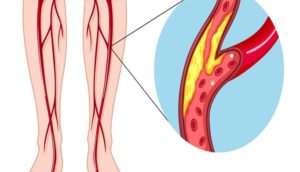 Peripheral artery disease (PAD) is caused by a narrowing of the peripheral arteries (arteries away from the heart) serving the legs, abdomen, arms, and head, but most commonly affects the arteries in the legs. It is primarily caused by the buildup of fatty plaque in the arteries (atherosclerosis). According to the Center for Disease Control, approximately 6.5 million people age 40 and older in the United States have PAD. If left undetected/untreated it can easily progress to a condition known as “critical limb ischemia” (CLI). This is the most severe form of PAD, and often leads to the most severe symptoms, including non-healing wounds and gangrene leading to amputation and even death. Because PAD can go from mild to no symptoms in the early stages to non-healing wounds, and tissue death (gangrene) leading to amputation in the later stages, early detection through screening is vitally important.
Peripheral artery disease (PAD) is caused by a narrowing of the peripheral arteries (arteries away from the heart) serving the legs, abdomen, arms, and head, but most commonly affects the arteries in the legs. It is primarily caused by the buildup of fatty plaque in the arteries (atherosclerosis). According to the Center for Disease Control, approximately 6.5 million people age 40 and older in the United States have PAD. If left undetected/untreated it can easily progress to a condition known as “critical limb ischemia” (CLI). This is the most severe form of PAD, and often leads to the most severe symptoms, including non-healing wounds and gangrene leading to amputation and even death. Because PAD can go from mild to no symptoms in the early stages to non-healing wounds, and tissue death (gangrene) leading to amputation in the later stages, early detection through screening is vitally important.
Atherosclerosis & PAD
Continuous and adequate blood flow is of vital importance to every organ and tissue of the body. Blood carries oxygen, heat, nourishment, electrolytes, hormones, and antibodies, to the tissues, and carries away waste matter and carbon dioxide. Like slowly turning off a faucet, with PAD, atherosclerosis progressively restricts blood flow. The tissues slowly become starved of the necessary benefits that adequate blood flow provides, and the negative effects begin to appear.
Signs & Symptoms
As mentioned above, many people with peripheral artery disease have mild or no symptoms, but the most common symptom is leg pain or cramping when walking (also known as claudication) that disappears after a few minutes of rest.
Other signs and symptoms of PAD include:
- Leg numbness or weakness
- Leg pain, tingling, or burning
- Hair loss or slower hair growth on your legs
- Coldness in your lower legs or feet
- Sores on your legs, feet, or toes that will not heal
- A change in the color of your legs
- Shiny skin on your legs
- Weak or no pulse in your legs or feet
Risk Factors
Risk factors for PAD include:
- Smoking
- Diabetes
- Obesity
- High blood pressure
- High cholesterol
- A family history of peripheral artery disease, heart disease or stroke
- Age 65+ or 50+ if you have any of the previous risk factors
If you are experiencing any of the above symptoms, or possess any of the above-mentioned risk factors, please have your screening done as soon as possible.
Your Screening & What to Expect
The good news is that your PAD screening is non-invasive, fast, easy, and painless. The test we will be performing will provide a value known as your ankle-brachial index (ABI), and involves the measurement of the blood pressure in the lower legs compared to the blood pressure in the arms. During this test, blood pressure cuffs are placed on the arms and legs. The cuffs are inflated, while a hand-held device (called a Doppler) is used to listen to the blood flow. This ABI screening evaluates the amount of blood flow to the legs and feet, which is decreased in a person with PAD. Your results will be evaluated by a physician and sent to you. Please be sure to share these results with your primary care physician. An ABI ratio between 1.0 and 1.4 is considered normal, and an ABI ratio of 0.9 or less means you have PAD.
If your screening is positive for PAD, you can expect your physician to recommend the following:
- Stop smoking
- Exercise regularly
- Maintain a heart healthy diet
- Lose weight if necessary
- Remain compliant regarding the management of diabetes, hypertension, and high cholesterol
- Remain compliant regarding all prescribed medications
- New medications may be prescribed
If you are experiencing any of the above symptoms, or possess any of the above-mentioned risk factors, please have your screening done as soon as possible.
